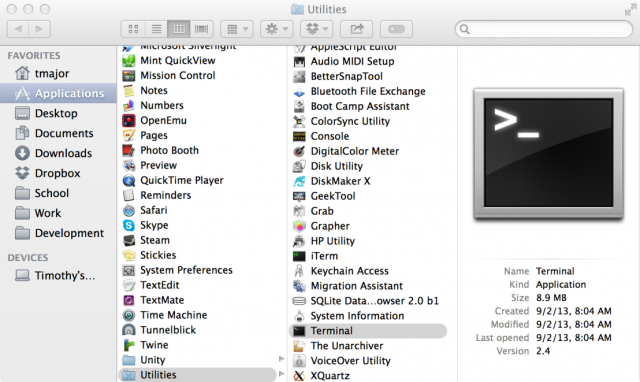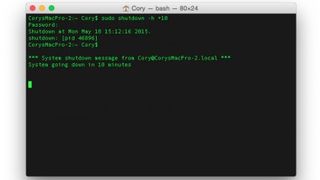
- #View shutdown timer terminal mac how to#
- #View shutdown timer terminal mac mac#
- #View shutdown timer terminal mac windows#
Hit the return key, authenticate with sudo to instantly shut down the Mac. Enter the halt command syntax exactly as described: sudo halt.
#View shutdown timer terminal mac mac#
The process and syntax for ‘halt’ to turn off a Mac is as follows: Open the Terminal. Automator is an app that doesn’t always get the love it deserves, but there’s an automation that can be created to quit all apps at the same time. When accurate measurement is essential you can rely on Timer, in addition to accuracy, you will find a lot of useful features: the stopwatch lets you check. The ‘halt’ command can also instantly shut down a Mac via the command line. There are plenty of folks who wish that macOS had the same Shortcuts app, but the truth is that there’s an app that’s more powerful and more useful. Quit All Apps With Automator MagicĮver since Apple introduced Shortcuts with iOS, we’ve provided a lot of coverage about saving time with automation. But there’s another way that you can quit all apps at the same time without pressing anything on the keyboard.
#View shutdown timer terminal mac windows#
Then select Force Quit, find the app you need to close, and click the Force Quit button.īoth macOS and Windows are quite verbose when it comes to offering keyboard shortcuts.
 In order to force quit a stubborn app, click the Apple logo in the Menu Bar. When using an app, click the app name in the Menu Bar, then select Quit App. Here are some keyboard shortcuts that you can use to quit apps on your Mac: One such task is the ability to quit all apps at the same time, without fiddling around with closing each app individually. But there are quite a few built-in keyboard shortcuts that allow you to perform different tasks with ease. That’s why folks live and die by apps like TextExpander or AutoHotkey (for Windows). Keyboard shortcuts are just that – tools to help save you some time. Regardless of the reason, there comes a time where you may need to quit all apps at the same time. Or maybe you just don’t want to go through and close each app that you don’t want open, one-by-one. Maybe you’ve finished up work for the day and want to get rid of those apps at once. There are a wide variety of reasons as to why someone would want or need to close all apps at the same time.
In order to force quit a stubborn app, click the Apple logo in the Menu Bar. When using an app, click the app name in the Menu Bar, then select Quit App. Here are some keyboard shortcuts that you can use to quit apps on your Mac: One such task is the ability to quit all apps at the same time, without fiddling around with closing each app individually. But there are quite a few built-in keyboard shortcuts that allow you to perform different tasks with ease. That’s why folks live and die by apps like TextExpander or AutoHotkey (for Windows). Keyboard shortcuts are just that – tools to help save you some time. Regardless of the reason, there comes a time where you may need to quit all apps at the same time. Or maybe you just don’t want to go through and close each app that you don’t want open, one-by-one. Maybe you’ve finished up work for the day and want to get rid of those apps at once. There are a wide variety of reasons as to why someone would want or need to close all apps at the same time. #View shutdown timer terminal mac how to#
How to Quit All Apps at the Same Time on Your Mac
 The Keyboard Shortcuts to Quit All Apps. How to Quit All Apps at the Same Time on Your Mac. This can be enabled separately for when your Mac is using its battery and when it’s connected to a power adapter. This allows your Mac to check for things like emails, calendar events, and iCloud updates while it’s asleep. You can also enable the Power Nap function. You will see multiple shutdown files popping up but you need to select the. The next menu lets you set the time at which your Mac will go to sleep and wake up on the specified days. Time to harness the potential of the Auto Shutdown feature on Windows 10. Use the drop-down menu that’s preset to Every Day to choose the specific days for which you want to set your sleep (or wake) timer. (You can also set an automatic wake timer by checking the box marked Start up or wake.) You can choose whether your computer will Shut Down or Restart. You can also schedule your sleep timer so your Mac automatically goes to sleep and wakes up at specific times.įrom System Preferences > Energy Saver, click the Schedule button on the bottom right of the window.Ĭheck the box marked Sleep to set a time at which your Mac will automatically go to sleep or shut down. It allows you to put your hard disks to sleep when they’re not in use, saving your computer’s power and increasing your disks’ lifespans. The "Put hard disks to sleep when possible" box. (Note: You can’t set the Display sleep slider for longer than the Computer sleep slider when your computer goes to sleep, your display will, too.) This turns your display off after being inactive for a set period of time. Set your monitor’s sleep using the Display sleep slider. This tells your computer to put itself into sleep mode after a set period of inactivity. Set sleep time using the Computer sleep slider (whether you have this option will depend on the version of macOS you’re using). You’ll see both of these options on the same screen.) (Note: If you’re on your iMac desktop, you won’t have multiple options, since your computer is always plugged into a power source. Each of these options has its own settings. If you’re using a Mac laptop, you’ll see two tabs: Battery and Power adapter. Go to System Preferences > Energy saver > Power adapter. Set your Mac’s sleep timerĬlick the Apple menu on the top left of your toolbar.
The Keyboard Shortcuts to Quit All Apps. How to Quit All Apps at the Same Time on Your Mac. This can be enabled separately for when your Mac is using its battery and when it’s connected to a power adapter. This allows your Mac to check for things like emails, calendar events, and iCloud updates while it’s asleep. You can also enable the Power Nap function. You will see multiple shutdown files popping up but you need to select the. The next menu lets you set the time at which your Mac will go to sleep and wake up on the specified days. Time to harness the potential of the Auto Shutdown feature on Windows 10. Use the drop-down menu that’s preset to Every Day to choose the specific days for which you want to set your sleep (or wake) timer. (You can also set an automatic wake timer by checking the box marked Start up or wake.) You can choose whether your computer will Shut Down or Restart. You can also schedule your sleep timer so your Mac automatically goes to sleep and wakes up at specific times.įrom System Preferences > Energy Saver, click the Schedule button on the bottom right of the window.Ĭheck the box marked Sleep to set a time at which your Mac will automatically go to sleep or shut down. It allows you to put your hard disks to sleep when they’re not in use, saving your computer’s power and increasing your disks’ lifespans. The "Put hard disks to sleep when possible" box. (Note: You can’t set the Display sleep slider for longer than the Computer sleep slider when your computer goes to sleep, your display will, too.) This turns your display off after being inactive for a set period of time. Set your monitor’s sleep using the Display sleep slider. This tells your computer to put itself into sleep mode after a set period of inactivity. Set sleep time using the Computer sleep slider (whether you have this option will depend on the version of macOS you’re using). You’ll see both of these options on the same screen.) (Note: If you’re on your iMac desktop, you won’t have multiple options, since your computer is always plugged into a power source. Each of these options has its own settings. If you’re using a Mac laptop, you’ll see two tabs: Battery and Power adapter. Go to System Preferences > Energy saver > Power adapter. Set your Mac’s sleep timerĬlick the Apple menu on the top left of your toolbar. 
You can also set a recurring schedule for your Mac to enter sleep mode. It’s possible to set your Mac to automatically start sleep mode after being inactive for a certain amount of time. Putting your Mac in sleep mode can help you save your battery life and get back to work quickly when you’re ready. Mac Help Desk Mac tips How to set the sleep timer on Mac?







 0 kommentar(er)
0 kommentar(er)
